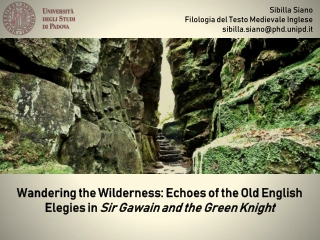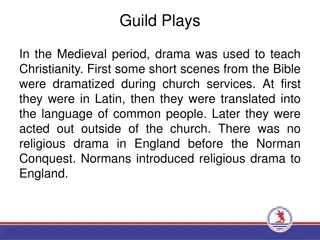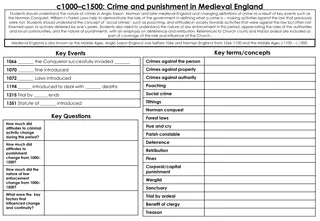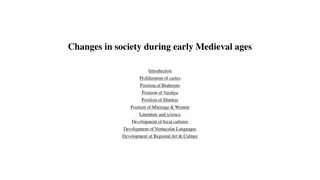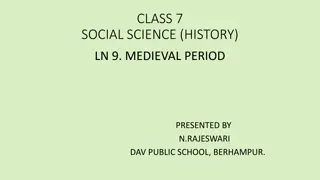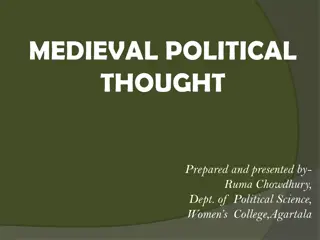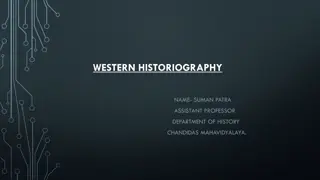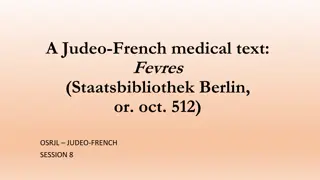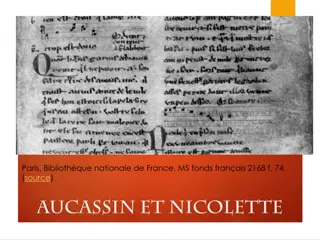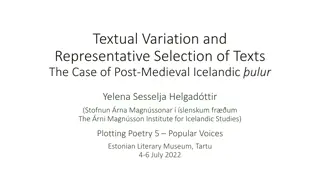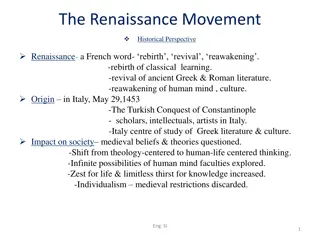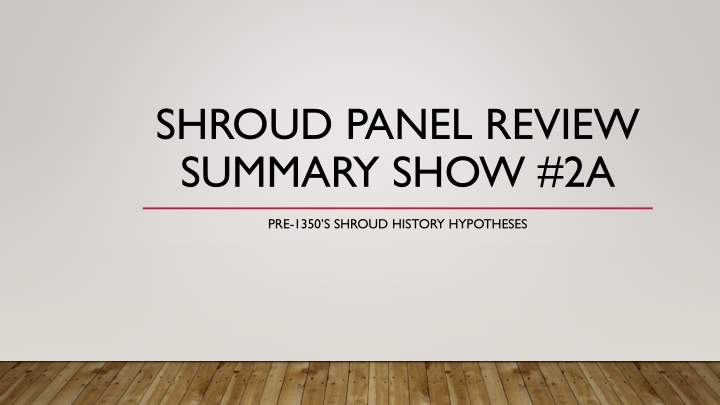
Medieval Missing Years: Shroud Historical Hypotheses Summary
Explore the historical hypotheses surrounding the Shroud of Turin's whereabouts from 1204 to 1356 A.D. Uncover theories about its journey from Constantinople to Lirey, France, supported by key historical texts and interpretations by experts.
Uploaded on | 0 Views
Download Presentation

Please find below an Image/Link to download the presentation.
The content on the website is provided AS IS for your information and personal use only. It may not be sold, licensed, or shared on other websites without obtaining consent from the author. If you encounter any issues during the download, it is possible that the publisher has removed the file from their server.
You are allowed to download the files provided on this website for personal or commercial use, subject to the condition that they are used lawfully. All files are the property of their respective owners.
The content on the website is provided AS IS for your information and personal use only. It may not be sold, licensed, or shared on other websites without obtaining consent from the author.
E N D
Presentation Transcript
SHROUD PANEL REVIEW SUMMARY SHOW #2A PRE-1350 S SHROUD HISTORY HYPOTHESES
THE MEDIEVAL MISSING YEARS (1204-1356 A.D.) 3 Fundamental Aspects; 1. Starting Point- Virtually all Pro-Shroud authenticists and experts believe that the Shroud was in Constantinople and attested to as Jesus burial shroud as of 1203/1204 A.D. just prior to the sacking of the city during the 4thCrusade. 2. Various Transfers- The Shroud is taken and transferred to one or more persons during the Missing Years period (details vary depending on the hypothesis postulated). 3. Ending Point- Starting in the mid 1350 s A.D., with Geoffrey 1 de Charney in Lirey, France, the Shroud s historical provenance is relatively uncontroversial for all (Pro-Shroud and Shroud skeptic alike)
RELEVANT HISTORICAL DATA The Shroud was not referenced much, if at all, after 1204. No explanation given for how Geoffrey 1stde Charny got the Shroud. Apart from the fact that it was freely given and not sold to him. In 1343 A.D., Geoffrey 1st(same year he becomes a knight) asks King Philip for financial help to build a church in small town of Lirey (suggesting he already had the Shroud prior to 1343 A.D. and wanted to build the church to show it).
5 RELEVANT HISTORICAL TEXTS (C. 1203-1356 A.D.) 1. Robert de Clari (August 1203-1204 A.D.)- Read Quote for Disappearance Fiction narrative in Ian Wilson, p.152. 2. Geoffrey de Villehardouin Chronicle (1204 A.D.)- written by a noble Crusader leader who doesn t explicitly mention the Shroud, but he tells us that just before the sacking of the city, the troops went to sleep and the leaders went into the city themselves first and garrisoned the two palaces with the relics in them (including the one Robert mentioned- Blachanae Palace-) so that the ordinary men would not touch any of the Passion Relics the following day = https://sourcebooks.fordham.edu/basis/villehardouin.asp 3. Nicholas of Otranto Disputation Report (1207 A.D.)- he lists off the palace relics after the sacking including the burial cloth relic when he came to the city in 1204/5 A.D. 4. Nicholas Mesarites Eulogy where Nicholas Mesarites, the former Byzantine custodian of the imperial relic collection who had affirmed, in 1201, that the Pharos Chapel housed the linen burial cloths of Jesus, was replaced by a Latin cleric and left Constantinople after it had fallen to the crusaders in April of 1204; however, when his brother, John, died in 1207, he returned to the capital and, in delivering his brother s eulogy, recited that the othonia and the sudariums of Jesus still remained in the city as of 1207 A.D. 5. Baldwin 2nd Golden Bull (1247 A.D.)- the Latin Emperor Baldwin II issued a Golden Bull in which he ceded, in perpetuity, all of his rights in twenty-two enumerated relics which his cousin, King Louis IX of France, had previously acquired and transported to Paris, one of which was "part of the shroud with which his (Jesus') body was wrapped in the tomb". (Irrelevant- Maybe a cut off piece of Shroud?)
THE MEDIEVAL MISSING YEARS HISTORICAL HYPOTHESES (1204-1356 A.D.) To date, there have been about 16 historical hypotheses proposed by Pro-Shroud experts to explain the whereabouts of the Shroud from the sack of Constantinople in 1204 A.D. to the exhibition of the Shroud in Lirey, France during the 1350 s A.D. 3 main types of theory; i) Text-Based Theories- Theories that attempt to account for all relevant historical texts during the period. ii) Ad Hoc/Fiction-Based Theories- Theories that are founded upon one or more unproven or fictional assumptions. iii) Forgery-Based Theories- Theories based on a forged letter known as the Theodore Letter (a proven forgery by secular historians based on 8-11 irrefutable or strong reasons- no original/copies for 700 years, obvious errors, wrong style, etc.).
SIX TEXT-BASED THEORIES Text-Based Theory 1. The Touchy Theory #1 (Original by Pietro Savio in 1957). 2. The Touchy Theory #2 (Modified theory by historian Dorothy Crispino in 1997 A.D.) 3. The Pawned Relic Theory (by Priest Paul De Gail in 1973 A.D.) 4. Saint Chappelle Theory #1 (by Andre-Marie Dubarle & Hilda Leynen (1998 A.D.) 5. Saint Chappelle Theory #2 (Mario Latendresse in ~ 2012). 6. The Simony Theory (by Jack Markwardt in 2017 A.D.)
SIXAD HOC/FICTION-BASED THEORIES Ad Hoc/Fiction-Based Theory 7. The Knights Templar Theory (by historian Ian Wilson in 1978-2010 A.D.) From Unknown thief in 1204, then sold or given to the Templars & after they lose Holy Land in 1291 A.D. bring it back to France to be inherited by Geoffrey 1stde Charney by 1350 s A.D. [Disappearance-Based Fiction]. 8. The Cathar Theory (by Jack Markwardt from 1997-2000 A.D.) This was Jack's original theory from 1997-2000 A.D. (he no longer holds this view- see Text-Based Theories above). Jack himself says while this is a plausible theory, he thinks the Knights Templar theory is superior all things considered given this theory says Geoffrey got the Shroud after 1343 A.D. and so doesn t explain his plan to build a church in small town Lirey when knighted. [Disappearance-Based Fiction]. [Disappearance-Based Fiction]. 9. The VostitzaTheory #1 (by Joseph Du Teil in 1902 A.D.) 10. The VostitzaTheory #2- Geoffrey crusaded in Smyrna. [Smyrna-Based Fiction]. 11. The Besancon Theory #1 (Dom Chamard in 1902 A.D.) [Othon De La Roche/Besancon-based Fiction].
FOUR FORGERY-BASED THEORIES (BASED ON THE FAKE THEODORE LETTER ) Forgery-Based Theory 13. The Athens-Templar Theory (by Noel Currer Briggs in 1988 A.D.) 14. The Athens-Smyrna Theory (by Daniel Raffard Di Brienne in 1997 A.D.) 15. The Ray-VergyTheory (by Alessandro Piana in 2007 A.D.) 16. The Ray-Vergy-Besancon Theory (by historian Daniel Scavone in 2008 A.D.).
INFERENCE TO THE BEST EXPLANATION We will assess the evidence for and against each theory in the light of the BEI or Best Explanation Inference criteria. Plausibility- prior probability of being true given our background knowledge. Explanatory Scope- how many facts and data points does it explain. Explanatory Power- how well does it fit the evidence and data. Less Ad Hoc- how many non-evidenced assumptions does it need to employ.
THEORY #7-THE KNIGHTS TEMPLAR THEORY The Knights Templar Theory- first proposed by historian Ian Wilson in 1978 A.D. Wilson argued that in 1204 an unknown person stole the Shroud in the chaos during the sacking of Constantinople. Then, at some point, the Shroud was somehow transferred to the Knights Templars who held it in the Holy Land until the last Crusader outpost Acre fell to the Muslims in 1290/1291 A.D. when they then took it to France to protect it. In 1307-1314 A.D. Geoffrey De Charney was the last Templar to own the Shroud but he was arrested and then burnt at the stake and so it was then transferred via inheritance through his family until it arrived at his descendant Geoffrey 1stde Charny who first exhibited it in the 1350 s A.D.
TEMPLAR THEORY-SPECIFIC FACTS 1. The Templar Head Idol - Part of the secret initiation ritual was to see the Supreme Vision of God on Earth that was held to be a head idol that was terrifying and awesome and represented God s presence on Earth in a way far more so than the normal Mass. Some debate about whether the Templars really worshipped a head or not (maybe just the French King s propaganda lies to go after them) & even if they did worship a head idol, there is no evidence of what it was (no mention of a cloth and images). 2. The Templecombe Panel- In 1951 A.D., a portrait panel discovered of a celestial head of Jesus that in some ways resembles similar facial portraits of Jesus and the Mandylion in the Byzantine Empire. Again no proof that links it to the Shroud vs. based on another cloth with Jesus head/face image on it.
TEMPLAR THEORY-SPECIFIC FACTS 3. Barbara Frale sVatican Letter- She was a Vatican Archive specialist and in 2008 claimed to have discovered a document mentioning the secret initiation ritual that said in 1287 A.D. Arnaut Sabbatier was shown a long linen cloth on which was imprinted the figure of a man (Wilson P.270). Unfortunately her credibility has been damaged as her translation of the word for linen has been proven to be false and is instead wood (see Ian Wilson and Andrea Nicoletti s critiques of her work on this). 4. Name Similarity- Geoffrey De Charnay burnt at the stake for heresy as a Knight s Templar- supposedly he had the Shroud and related to Geoffrey 1stDe Charny who showed the Shroud in the 1350 s. Unfortunately, there has been no proof at all to demonstrate any relations between the two Geoffrey's to date (over 40 years now), the name is very common as Charny refers to a place and there is different spellings of the names (though at that time spelling was not standardized and doesn t prove or disprove anything).
ASSESSING THEORY #7- THE KNIGHT S TEMPLAR THEORY Plausibility- Generally speaking, this theory is historically plausible and consistent with our background knowledge. The Templars had the means, motive and opportunity to obtain, hide and pass on the Shroud. Plausibility may depend on background knowledge of whether the Shroud was the Mandylion/Image of Edessa vs. Image of God Incarnate or perhaps another burial Shroud held in Constantinople. Explanatory Scope- This theory does account for Robert De Clari s Chronicle very well, however, it is based on the Disappearance- narrative and as such it seems to be inconsistent with other texts that mention the burial shroud/s being present in Constantinople in possession of the Latin Emperors post 1204 A.D. (from 1205-1207 A.D. and possibly beyond). That said, these other texts may be referring to another shroud cloth with images as there were at least 2 in Constantinople. Explanatory Power- This theory does have good explanatory power (outside of explaining some of key texts) in that it explains why the Shroud went missing in 1204, the silence in terms of how Geoffrey 1st was freely given the Shroud, and Geoffrey's 1343 plan to build Lirey church. Less Ad Hoc- Assumes with no evidence that Geoffrey De Charney burnt as Knights Templar is related to Geoffrey 1stde Charney who first showed Shroud. Peer-Review/Scholarly Consensus: Ian Wilson has not defended his views in the peer-reviewed literature, but it has been critiqued by several historians and scholars since 1978; for example, see Dan Scavone (who supports Wilson on Mandylion/Image of Edessa), Malcom Barber (Templar scholar says no such thing as a Templar idol) and Gian Maria Zaccone (says no proof for the theory).
ASSESSING THEORY #6- THE SIMONY THEORY Proposed by Jack Markwardt in 2017 A.D. The Shroud stayed in Constantinople after 1204 A.D. as a relic of the Latin Emperors until Baldwin 2ndwhen he went bankrupt and needed money desperately; so he wanted to sell off his relics (22 of them total) to King Louis 9thof France (a saintly king) between 1239-1241 A.D. But buying and selling holy relics was the mortal sin of simony which entailed the King could lose his thrown and so they did a relic as collateral scheme (confirmed by the 1247 A.D. Golden Bull). For the Shroud, Louis pays a King s ransom to free Baldwin s son (mistakenly thinking this avoided the sin of simony), but his advisors told him he had to get rid of it. He secretly gave it to his good friend Jean de Joinville (owner of Lirey as of 1290 A.D.) to hold for him. King left him behind and dies on crusade and so Jean then keeps the Shroud until he dies. Not able to reveal it as King would lose his sainthood. Between 1290-1295, his daughter marries the knight Jean de Charny. Joinville is 85 years old and so Shroud given as Dower property (for the woman to retain on her own apart from husband to dispose of anyway she wishes). Margaret de Charny swore oath to her father not to reveal how Shroud obtained. In 1306 A.D., she dies young and so she left her dower property to her non- eldest son Geoffrey 1stas an inheritance.
ASSESSING THE SIMONY THEORY Plausibility- This theory is historically plausible given the background knowledge. The acquisition and transfers of the Shroud are all plausible. This is also consistent with the evidence of Luis lust for holy relics at this time and his ransom of Philip (son of Baldwin) and fits with our new knowledge (as of 1996 A.D.) that Geoffrey 1stwas Joinville s grandson via marriage. Explanatory Scope- This theory does account for all of relevant texts mentioning the Shroud in Constantinople post-1204 A.D. There is potentially some strain in explaining the part of Robert De Clari s Chronicle attesting to the Disappearance-narrative and as such it seems to be inconsistent with other text, however, this part of the text is unsubstantiated. Explanatory Power- This theory does explain why the Shroud was unmentioned during the missing years and the freely given aspect. It also adequately explains why there would be silence on how Geoffrey 1stgot the Shroud as well as Geoffrey 1st s 1343 A.D. plan to build church as he inherited it prior to that date. Less Ad Hoc- No non-evidenced assumptions employed for the theory to work. Peer-Review: New Theory- none yet!
SHROUD SKEPTICS QUEM QUAERITIS THEORY Hugh Farey s Quem QuaeritisTheory- See Hugh explain his own theory in my Shroud Panel Review Part 2B show (from the 25 min mark Jack asks Hugh question to 33 min mark). Hugh says the Shroud images were probably made around the 1290 s A.D. [Originally he proposed the 1340 s A.D.].
ASSESSING QUEM QUAERITIS THEORY Plausibility- This theory is historically plausible given the background knowledge in so far as the Quem Quaeritis ceremony was widely known to have been practiced throughout France at this time (though Jack Markwardt is now working on a paper that may counter this claim). However, it may lack plausibility it is unlikely that the cloth would have been freely given to a small town church like Lirey vs. another bigger one. If the ritual was as common as Hugh notes and all of them regularly involved images on the shrouds used, then why would anyone fall for the Shroud of Turin as legit- the masses would all know it s a fake and not pay money for it in Lirey. But more likely, images were not commonly on these ritual shrouds and so only the Shroud of Turin taken as real, so it s a deliberate fake then? Explanatory Scope- This theory does NOT account for all of the relevant texts mentioning the Shroud in Constantinople post-1204 A.D. However, it may be that these texts refer to other shroud/burial cloths and not the Shroud of Turin. Explanatory Power- This theory doesn t specify or prove the when, how and why it was freely given to Geoffrey 1st. It does explain why the Shroud was unmentioned during some of the missing years (namely it didn t exist to be mentioned in the first place). It does explain the freely given aspect and potentially explains Geoffrey 1st s 1343 A.D. plan to build Lirey church (possible he got it before that date.). Fails to adequately explain why there would be silence on how Geoffrey got the Shroud. Finally, this theory does not fit the fact that none of the Quem Quaeritis ceremonies written about in texts mention anything about images on the cloths used. LessAd Hoc- Hugh admits that this theory is pure speculation with no direct evidence to support it. None of the other shrouds from these rituals survive to the present day, thus, skeptics must assume that they involved images on the cloth without any provable textual or archeological confirmation. Peer-Review: None.
SHROUD SKEPTICAL EVIDENCE -THE 1389 D'ARCY MEMO - There are several historical documents dating to the Medieval period, which Shroud skeptics claim prove the Shroud is medieval in origin; The most infamous is the D'Arcis Memorandum (c. Pre-August 15th 1389 A.D.). The Memo was allegedly written by Bishop Pierre D'Arcis of Troyes and he says; The Lord Henry of Poitiers, of pious memory, then Bishop of Troyes, becoming aware of this, and urged by many prudent persons to take action, as indeed was his duty in the exercise of his ordinary jurisdiction, set himself earnestly to work to fathom the truth of this matter Eventually, after diligent inquiry and examination, he discovered the fraud and how the said cloth had been cunningly painted, the truth being attested to by the artist who had painted it, to wit, that it was a work of human skill and not miraculously wrought or bestowed .
THE 1389 D'ARCY MEMO - 7 ALLEGATIONS - 1. Robert De Caillac, the Dean of Lirey, procured the Shroud out of greed for his own financial gain. 2. The Shroud images had been cunningly painted . 3. The Dean exhibited the Shroud in Lirey and represented it as Jesus actual burial Shroud to induce people from all parts of the world to come and venerate it. 4. While showing the Shroud, the Dean also staged bonus miracle healings. 5. The former Bishop of Troyes, Henri De Poitiers, conducted an inquiry where the (an) artist confessed to having painted the Shroud s images in 1355 A.D. or thereabouts. [As per Allegation #7 below, 34 years or thereabouts = 1389 A.D.- 34 years = 1355 A.D.]. 6. After consulting with wise theologians and men of the law , Bishop Henri started to institute formal proceedings against the Dean and his accomplices. 7. The Dean then hid the Shroud for 34 years or thereabouts [1389 A.D.- 34 years = 1355 A.D.].
ASSESSING THE 1389 D'ARCY MEMO All extant copies of this Memo are unsigned and undated drafts with words marked for deletion (using the Latin "vacat" in the margin). The Bibliotheque Nationale of Paris possesses two copies of the Memorandum (Labelled Folio 137 and 138)- neither is dated and one of them is incomplete and heavily edited. The translation given above utilizes a compilation of both of these texts. The Memo was never officially sent to the Pope (even the ultimate Shroud skeptic Hugh Farey admits this!) Questions about the translation of the Latin- for example, does it say the artist or an artist . Circumstantial evidence proves D'Arcis himself had a possible financial motive to lie about the Shroud as he needed the money from the Shroud to help with costly repairs on his church after it was damaged in 1389. No later external records speak of this Memo or of it s contents (E.g. Nicolas Camusat in the 1600 s). Finally, the external evidence from other relevant medieval documents, dated from the 1350 s to 1390 A.D., do not mention an inquiry, artist or the Shroud having been cunningly painted at all.
ASSESSING THE 1389 D'ARCY MEMO - RELEVANT TEXTS FROM 1389-1390 A.D. - Anti-Pope Clement VII s Letter Brief to Geoffroy II, dated 28 July 1389 (sent about five months or less before the Memorandum of Bishop d'Arcis written). Clement acknowledges the Charnys' religious motives for showing the cloth and agrees that it had been removed from the church and brought to safety because of war and pestilence. He permits the showing of the cloth publicly, but calling it a "figure or representation," and on Bishop d'Arcis, Clement imposes "perpetual silence." The Brief mentions no inquest, artist, or scandal. Letter from King of France Charles VI to the Bailly of Troyes, dated 4 August 1389. "The Bishop of Troyes has stated before our Curia that the church in Lirey is displaying a certain handmade and artificially depicted cloth as if it were the true Sudarium Christi." The king commands the Bailly "to get the cloth and bring it to me so that I might relocate it in another church in Troyes." Report of the Bailly of Troyes, dated 15 August 1389, says, in essence: We went to the church at Lirey, but the Dean would not hand it over to us, and we did not proceed further in the matter . Letter from the First Sergeant of the King to the Bailly of Troyes, dated 5 September 1389: The writer says he officially announced to the Dean and to Geoffroy II that the cloth was verbally made the property of the King. Nothing, in the end, came of this.
RELEVANT TEXTS FROM 1389-1390 A.D. CONT. Clement's letter to Bishop d'Arcis, dated 6 January 1390: Written after the Memo but not referring to it, as was customary at that time; this letter says that the cloth was placed in the Lirey church with Clement's permission, despite the Bishop's prohibition, and any opposing action would be visited with excommunication. Papal Bull of Clement VII, dated 6 January 1390: later that same day, the Pope admits he has changed his mind. First he repeats the words of his letter to Geoffroy II of 28 July 1389. He again orders d'Arcis to perpetual silence. Then follow the modifications: To remove every chance of error or idolatry in the display of the cloth, we ordain that whenever said figure or representation is displayed, one should announce loud and clear that it is not the true Sudarium of the Lord, but a picture or copy only. Potential Problems Using the Above Text in Isolation; 1. This is historically irrelevant as there is no proof that the Pope s reason for making this proclamation was based on sound reasons for thinking it to be inauthentic as opposed to making it for other human-based reasons. It proves nothing (as Hugh Farey admits himself). The Anti-Pope didn t really have solid evidence one way or the other in terms of authenticity. 2. If Hugh, wishes to argue that as a Papal Bull the Pope was speaking as an inerrant or inspired representative of Jesus/God, then I d just argue that other Bulls by Clement and other Popes contradict this Bull (and also Clement was an Anti-Pope not a proper Pope?) so his opinions on the Shroud are merely man-made and not inspired or infallible. Doc. I. Papal Bull dated 1 June 1390: Six months later Clement changes his mind again. He now supports the Lirey shroud, making no mention of idolatry. He says, Since we have heard that crowds go to Lirey out of devotion to the cloth, we, desiring to encourage this pilgrimage, enlarge the indulgence for the faithful who visit said church annually at Christmas, etc. And we strictly prohibit anyone, of whatever rank, from appropriating or usurping the offerings of the faithful .
ASSESSING THE 1389 D'ARCY MEMO - RELEVANT TEXTS FROM 1356-1357 A.D. - Bishop Henri de Portier s only letter addressed to Geoffroy I de Charny (the original owner of the Shroud)--dated 28 May 1356: Its contents are a direct refutation of the 1389 Memo; the Bishop informs Geoffroy I that he is satisfied with all he has done for the divinum cultum (divine cult) and adds his laudamus, ratificamus, approbamus (we praise, ratify and approval) for it. Thus, Henri de Poitier supported Geofferey 1stand the Lirey church as of 4 months prior to Geoffrey's death on Sept 18th1356 A.D. in the battle of Portier; there exists no historical document relating to Henri de Poitier's inquiry, no document alluding to his appointing a commission,nor the confession of an artist saying they cunningly painted the Shroud images. Pontifical Avignon Curia Bull dated 5 June 1357: Gives extended indulgences to Lirey church and tells visitors to gain indulgences by visiting the relics there (no mention of Shroud, so it is not there at this time and is hidden). Bishop D'Arcy never personally met Bishop Henri as Henri died in 1370 A.D. and D'Arcy only came to Lirey in 1373-1377 A.D. None of these primary documents from 1356 to 1390, aside from the Memorandum, refers to an inquest or artist in 1355. Rather, Henri's letter praised Geoffroy I and Anti-Pope Clement VII in the end granting more indulgences than ever to visitors to Lirey suggest the opposite. Further, the documents also force us to conclude that neither Henri nor d'Arcis nor Clement ever saw the Shroud itself in Lirey. An astute historian might ask why, just months before the drafting of his 1389 Memo, did D'Arcis, a canon lawyer, not cite the damning evidence of Henri's inquest or the name of the artist? Had he done so, it would surely have been recited in the King's letter. Instead, the King mentions only D'Arcis' charge, not Henri's charge, that the image on the cloth was handmade.
BISHOP HENRI DE POITIERS LETTER OF MAY 28, 1356 TO GEOFFREY I DE CHARNY YOU WILL LEARN (OF GEOFFREY 1stDE CHARNY S) SENTIMENTS OF DEVOTION, WHICH HE HAS HITHERTO MANIFESTED FOR THE DIVINE CULT AND WHICH HE MANIFESTS EVER MORE DAILY. AND OURSELVES WISHING TO DEVELOP AS MUCH AS POSSIBLE A CULT OF THIS NATURE, WE PRAISE, RATIFY AND APPROVE THE SAID LETTERS IN ALL THEIR PARTS A CULT WHICH IS DECLARED AND REPORTED TO HAVE BEEN CANONICALLY AND RITUALLY PRESCRIBED, AS WE HAVE BEEN INFORMED BY LEGITIMATE DOCUMENTS.
OBJECTION: WHY IS THERE PAPAL WAFFLING? A Shroud skeptic may admit defeat in being able to positively prove their case, but they may raise the issue of why Pope Innocent is silent on the Shroud in the 1350 s if he supposedly approved it being exhibited and why does Pope Clement waffle back and forth with his support for the Shroud vs. saying it is only a representation ? Play Jack Markwardt s Explanation from 19:20 min mark to the end = https://www.youtube.com/watch?v=WoqAEi5TnWw Simony Theory provides illumination (i.e., fulfills the bonus criterion of illumination) on the Pope s take on the Shroud from 1350-1390 A.D. whereas Knights Templars theory doesn t.
FINISHED PART 2 BELOW IS BONUS NOTES/SLIDES
AD HOC/FICTION-BASED THEORIES: 3 HISTORICAL FICTIONS 1. The Disappearance Fiction- The Shroud disappeared in the chaos of the Crusade sacking of the city in 1204 A.D. 2. The Smyrna Fiction- Geoffrey 1st de Charney went on Crusade to Smyrna to get the Shroud (he knew it was over there). 3. The Othon de la Roche/Besancon Fiction- In 1523 A.D., a Shroud shows up in Besancon France and the clergy need to explain how it is an authentic relic and so they make up a story to make it a Byzantine relic via Othon De Laroche, a supposed crusader who got it in 1204 A.D. sack and then took it to Athens and then later to his home town cathedral in Besancon, France. [The clergy of 1711 A.D.??? Said that it arrived in 1350 s not 1523 A.D.].
PRO-SHROUD EXPLANATION FOR THE RELEVANT HISTORICAL DATA No official Papal Bull from the 1350 s approving the Shroud as authentic. No reference to the Shroud in the 1350 s in the Vatican archives. No mention of the Shroud s provenance by either Geoffrey 1st or the Pope in the 1350 s (i.e., where it came from and how Geoffrey 1stgot it as a free gift ).
CANON 62 OF THE FOURTH LATERAN COUNCIL (1215) IN THE FUTURE OLD RELICS MAY NOT BE EXHIBITED OUTSIDE OF A VESSEL OR EXPOSED FOR SALE. AND LET NO ONE PRESUME TO VENERATE PUBLICLY NEW ONES UNLESS THEY HAVE BEEN APPROVED BY THE ROMAN PONTIFF. IN THE FUTURE PRELATES SHALL NOT PERMIT THOSE WHO COME TO THEIR CHURCHES CAUSA VENERATIONIS (FOR PURPOSE OF VENERATION) TO BE DECEIVED BY WORTHLESS FABRICATIONS OR FALSE DOCUMENTS AS HAS BEEN DONE IN MANY PLACES FOR THE SAKE OF GAIN.

